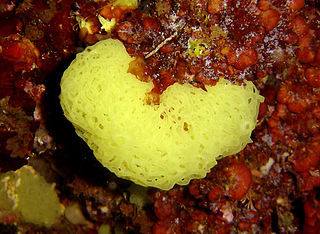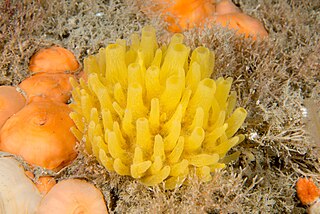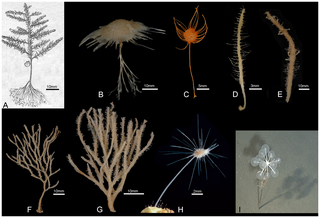
Cladorhiza is a genus of carnivorous sponges, comprising around 40 species found in oceans around the world. Cladorhiza is the type genus of the family Cladorhizidae.

Clathrina is a genus of calcareous sponge in the family Clathrinidae. Several species formerly in Clathrina were transferred to the newly erected genera Arturia, Ernstia, Borojevia, and Brattegardia in 2013. The name is derived from the Latin word "clathratus" meaning "latticed".

Grantia is a genus of calcareous sponges belonging to the family Grantiidae. Species of the genus Grantia contain spicules and spongin fibers.

Polymastia is a genus of sea sponges containing about 30 species. These are small to large encrusting or dome-shaped sponges with a smooth surface having many teat-shaped projections (papillae). In areas of strong wave action, this genus does not grow the teat structures, but instead grows in a corrugated form.

Chondrocladia is a genus of carnivorous demosponges of the family Cladorhizidae. Neocladia was long considered a junior synonym, but has recently become accepted as a distinct genus.

Auletta is a genus of sponges in the family Bubaridae.
Homaxinella is a genus of sea sponges in the family Suberitidae. The type species is Homaxinella balfourensis.

Myxilla is a genus of demosponge belonging to the family Myxillidae. These sponges usually form encrustations on rock surfaces.
Neopetrosia is a genus of marine petrosiid sponges. It was first established by the American spongiologist Max Walker de Laubenfels in 1932. It contains these 27 species:

Cladorhizidae is a family of carnivorous demosponges found in deep-sea environments worldwide. These sponges are known for their unique feeding structures and predatory behavior, as they capture and consume small animals such as crustaceans.
Cladorhiza caillieti is a carnivorous sponge of the family Cladorhizidae described in 2014 from specimens collected from the Juan de Fuca Ridge off the coast of Vancouver Island. It feeds on small crustaceans such as amphipods and copepods. C. caillieti is an elongate, bottlebrush-shaped sponge with filaments projecting from a main stem, and ranges from 7 to 9 cm in height. The specific epithet honors Dr. Gregor M. Cailliet of the Moss Landing Marine Laboratories.
Ciocalypta is a genus of sea sponges belonging to the family Halichondriidae.
Dragmacidon is a genus of sponges in the family Axinellidae, first described in 1917 by E.F.Hallman .

Abyssocladia is a genus of the family Cladorhizidae, a family of carnivorous sponges. It is made up of at least 39 species found in oceans all over the world.
Axoniderma australis is a species of demosponge in the family Cladorhizidae. It is known from type specimens found off the coasts of Tasmania and New South Wales.
Axoniderma poritea is a species of demosponge in the family Cladorhizidae. It is known from type specimens found on the east coast of Australia.
Axoniderma corona is a species of demosponge in the family Cladorhizidae. It is known from type specimens found near the Aleutian Islands.
Axoniderma hubbsi is a species of demosponge in the family Cladorhizidae. It is known from type specimens found in the northeast Pacific Ocean.
Axoniderma kensmithi is a species of demosponge in the family Cladorhizidae. It is known from type specimens found in the Pacific Ocean off the coast of California.
Axoniderma mexicana is a species of demosponge in the family Cladorhizidae. It is known from type specimens found around Mexico.








